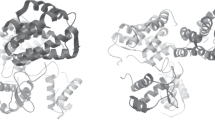Abstract
UxuR is a transcription factor that controls the expression of genes involved in hexuronate utilization. Its ability to bind to the promoters of regulated genes is dependent on sugar ligands. Two regions of the preferred interaction with D-glucuronate and D-galacturonate were found on the surface of the UxuR monomer earlier, one of which was located in the flexible linker connecting the N- and C-terminal domains of the protein. Binding of a ligand in this region may change the mutual orientation of the domains, thereby affecting the interaction of UxuR with DNA. The second binding region was found within the pocket of the C-terminal domain from where the regulatory effect may be explained either by conformational changes in the domain, or by influence of sugar ligands on the protein dimerization. Here, a 3D-model of the UxuR dimer was obtained and molecular docking of a range of sugars on its surface was performed. Additional platform for carbohydrate binding was found in the junction of the two C-terminal domains in the UxuR dimer. Interdomain linkers were occupied by different sugars including those that were able to penetrate into the pockets of the C-terminal domains from the side of interdomain space. Potentially, this allows transposing regulatory signal derived from the pocket loading into the conformation transition that changes mutual orientation of the domains.




Similar content being viewed by others
REFERENCES
D. E. Chang, D. J. Smalley, D. L. Tucker, et al., Proc. Natl. Acad. Sci. U. S. A. 101, 7427 (2004).
A. J. Fabich, S. A. Jones, F. Z. Chowdhury, et al., Infect. Immun. 76, 1143 (2008).
N. Peekhaus and T. Conway, J. Bacteriol. 180, 3495 (1998).
N. J. Sweeney, D. C. Laux, and P. S. Cohen, Infect. Immun. 64, 3504 (1996).
A. Ashwell, A. J. Wahba, and J. Hickman, Biochim. Biophys. Acta 30, 186 (1958).
A. Ashwell, A. J. Wahba, and J. Hickman, J. Biol. Chem. 235, 1559 (1960).
P. Ritzenthaler, M. Mata-Gilsinger, and F. Stoeber, J. Bacteriol. 143, 1116 (1980).
R. Portalier, J. Robert-Baudouy, and F. Stoeber, J. Bacteriol. 143, 1095 (1980).
D. A. Rodionov, A. A. Mironov, A. B. Rakhmaninova, and M. S. Gelfand, Mol. Microbiol. 38, 673 (2000).
P. Ritzenthaler and M. Mata-Gilsinger, J. Bacteriol. 150, 1040 (1982).
I. A. Suvorova, M. N. Tutukina, D. A. Ravcheev, et al., J. Bacteriol. 193, 3956 (2011).
S. Rigali, A. Derouaux, F. Giannotta, and J. Dusart, J. Biol. Chem. 277, 12507 (2002).
C. Bates Utz, A. B., Nguyen, D. J. Smalley, et al., J. Bacteriol. 186, 7690 (2004).
M. N. Tutukina, A. V. Potapova, J. A. Cole, and O. N. Ozoline, Microbiology 162, 1220 (2016).
T. Lengauer and M. Rarey, Curr. Opin. Struct. Biol. 6, 402 (1996).
S. F. Sousa, A. J. Ribeiro, J. T. Coimbra, et al., Curr. Med. Chem. 20, 2296 (2013).
T. A. Bessonova, S. A. Shumeiko, Yu. A. Purtov, et al., Biophysics (Moscow) 61 (6), 825 (2016).
N. M. O’Boyle, M. Banck, C. A. James, et al., J. Cheminform. 3, 33 (2011).
M. D. Hanwell, D. E. Curtis, D. C. Lonie, et al., J. Cheminform. 4 (1), 17 (2012).
M. Riley, T. Abe, M. B. Arnaud, et al., Nucleic Acids Res. 34 (1), 1 (2006).
A. Waterhouse, M. Bertoni, S. Bienert, et al., Nucleic Acids Res. 46 (W1), W296 (2018).
M. S. Little, S. J. Pellock, W. G. Walton, et al., Proc. Natl. Acad. Sci. U. S. A. 115, E152 (2018).
N. Guex and M. C. Peitsch, Electrophoresis 18, 2714 (1997).
M. S. Friedrichs, P. Eastman, V. Vaidyanathan, et al., J. Comput. Chem. 30, 864 (2009).
O. Trott and A. J. Olson, J. Comput. Chem. 31, 455 (2010).
G. M. Morris, R. Huey, W. Lindstrom, J. Comput. Chem. 30, 2785 (2009).
Author information
Authors and Affiliations
Corresponding author
Additional information
Translated by E. Puchkov
Abbreviations: CTD, C-terminal domain.
Rights and permissions
About this article
Cite this article
Purtov, Y.A., Tutukina, M.N., Nikulin, A.D. et al. The Topology of the Contacts of Potential Ligands for the UxuR Transcription Factor of Escherichia coli as Revealed by Flexible Molecular Docking. BIOPHYSICS 64, 49–56 (2019). https://doi.org/10.1134/S0006350919010160
Received:
Revised:
Accepted:
Published:
Issue Date:
DOI: https://doi.org/10.1134/S0006350919010160




